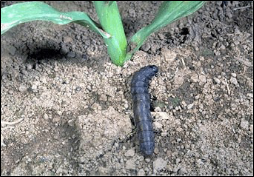Cutworms in Corn
Cutworms
Description
Larvae are light gray to nearly black and may have a faint, narrow mid-dorsal stripe. Larvae vary from 1/4 inch long after hatch to 1-3/4 inches long when full grown.

Black cutworm
Ric Bessin, University of KY
Damage
Small larvae chew small holes in the leaves. Larger larvae (about 1/2 inch long) cut small plants and may pull parts into their burrows. Symptoms are cut or wilted plants.
Pest Activity
Please note: These dates are approximations only. This calendar was constructed using data from Kentucky, USA. These dates may not apply in your area. You may wish to contact your county extension agent or agricultural consultant for information tailored to your locality.
IPM Techniques and Scouting Procedures
Cutworms occur in the time period from planting through mid-June. Fields having one or more of the following characteristics should be watched very carefully:
- a history of cutworm damage
- surface litter present--especially soybean residue
- fair to poor drainage or subject to flooding
- planted late
- contained winter annual weeds prior to tillage.
Corn plants should be monitored twice weekly from emergence until they reach a height of 18 inches. Watch for leaf feeding, wilted plants or cut stalks. Infestations are often spotty so check carefully for damage. Make counts only if cutworm damage is noticed in the field. Continue to scout damaged fields once an infestation is found. It is vital to get planting dates so fields will not be overlooked during this critical period when the plants are small.
Begin making counts as follows when cut or wilted plants are first seen:
1) Randomly determine each starting point.
- Examine 20 consecutive plants per location and write down the number of cut plants.
- Determine the percent plants cut by dividing the total plants cut by the total number of plants inspected.
- Multiply this figure by 100 and record the percent infestation on the report form.
2) Look for live cutworms around freshly damaged plants. They will generally be covered or underground during the day.
- First check under clods near the base of the plant.
- Then, dig up an area three inches in diameter and three inches deep around the plant.
- Record the average number and length (inches) of "live" cutworms per 100 plants and whether they were found near the soil surface or deep.
- Place some specimens in vials containing alcohol for identification by the scout supervisor.
3) Make stand counts in the field. These counts can be used in making a treatment decision.
The economic threshold is 3% or more cut plants and 2 or more cutworms (l inch or smaller) per 100 plants. Inform the grower and supervisor immediately. If conditions are borderline, check the field again in 24 to 48 hours or until a final decision is made. Take stand counts during this time to help determine if treatment may be necessary.
References and Additional Information
- IPM-2 Kentucky Corn IPM Manual
- ENTFACT 302 - Sweet Corn Pests


